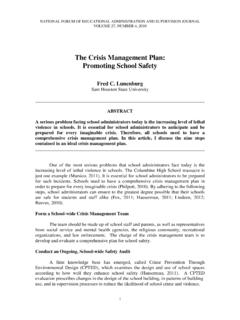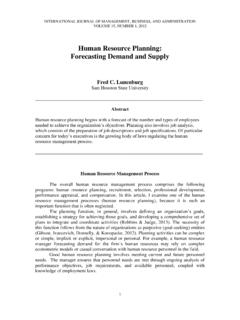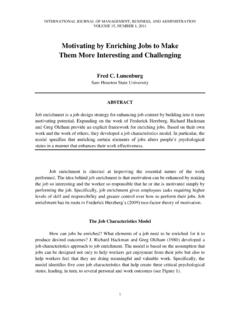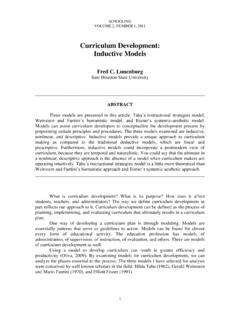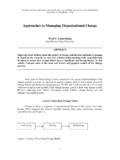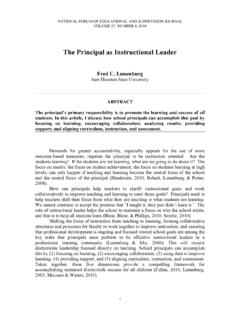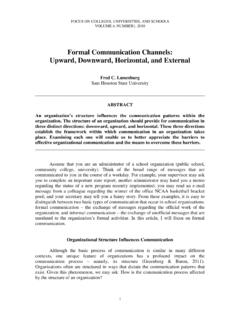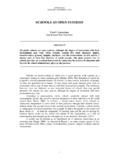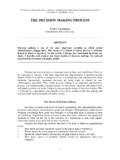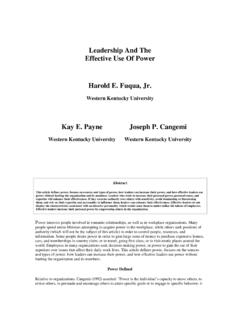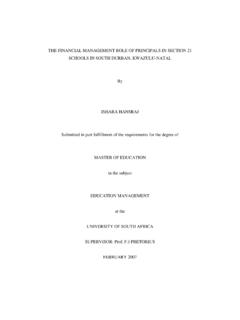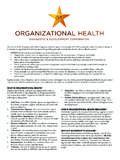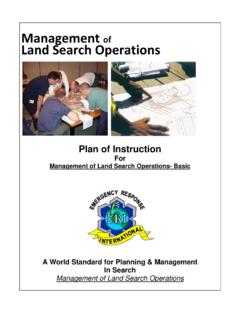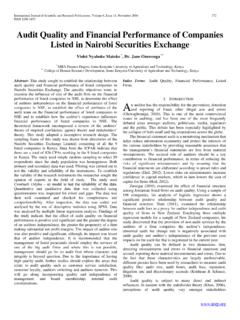Transcription of The Management Function of Principals - National Forum
1 National Forum OF EDUCATIONAL ADMINISTRATION AND SUPERVISION JOURNAL VOLUME 27, NUMBER 4, 2010 1 The Management Function of Principals Fred C. Lunenburg Sam Houston State University _____ ABSTRACT Some scholars believe that Management is a prerequisite to leadership. You can t change something unless it is a viable system in the first place. Management of the day-to-day operation of a school is essential. In this article, I discuss the key elements of organizational structure. The six elements are: job specialization, departmentalization, delegation, decentralization, span of control, and line and staff positions.
2 _____ Most of the recent literature on the principalship has focused on the role of the principal as instructional leader (Glickman, 2010). But Management is important in addition to instructional leadership (Jones, 2010; Kruse & Louis, 2009). We know that when school improvements occur, Principals play a central role in (a) ensuring that resources money, time, and professional development align with instructional goals, (b) supporting the professional growth of teachers in a variety of interconnected ways, (c) including teachers in the information loop, (d) cultivating the relationship between the school and community, and (e) managing the day-to-day tasks of running a school.
3 Each of these is viewed as a Management task in the sense that it involves daily or weekly attention to problem solving within the school and between the school and its immediate environment. Some scholars believe that Management is a prerequisite to leadership (Lunenburg & Irby, 2006; Lunenburg & Ornstein, 2008). You can t change something unless it is a viable system in the first place. It has to continue to survive while you take it to the next level. Management of the day-to-day operation of a school is essential. The leadership, though, is how we are going to make the system work better?
4 Leaders ask questions, such as: What is the business we are in? What is it we are trying to do? How are we going to put all of our resources together to continue to grow, to continue to respond to new needs, to enable schools to be places where engaged teaching and learning occur? Very often good leaders, although they know the Management skills, don t take the time personally to practice the Management skills. And part of leadership is knowing what you do best and using all of your available resources. Thus, Principals work with students, teachers, parents, and other school stakeholders to set up organizational structures and help to develop other people in the school by delegating and very carefully monitoring the Management functions in the school.
5 National Forum OF EDUCATIONAL ADMINISTRATION AND SUPERVISION JOURNAL 2_____ Think of all the activities employees perform in a school: scheduling classes, ordering supplies, maintaining student records, teaching classes, cleaning classrooms, preparing food, driving buses, typing letters, photocopying, and the like. If you were to make a list, you would probably identify several hundred different tasks. Without some structures, policies, and processes, would all the required tasks be performed efficiently and effectively? Who will teach the classes, clean the classrooms, wash the chalkboards, serve lunch in the cafeteria, drive the buses, or mail student report cards?
6 The Management Function of organizational structure is the process of deploying human and physical resources to carry out tasks and achieve school goals (Ivancevich, Konopaske, & Matteson, 2011). How do Principals manage the day-to-day activities of the school and, at the same time, work toward the school s improvement. They don t do it alone. Key Elements of Organizational Structure In this section, I will describe six basic elements of organizational structure: job specialization, departmentalization, delegation, decentralization, span of Management , and line and staff authority (Robbins & Judge, 2011).
7 Job Specialization The most basic concept of organizational structure is job specialization the degree to which the overall task of the school is broken down and divided into smaller, component parts. For example, a school may employ Principals , school psychologists, social workers, counselors, teachers, and many other support staff including secretaries, food service personnel, maintenance workers, bus drivers, and the like. This specialization of tasks provides an identity for the job and those performing it, which collectively adds back to the total.
8 That is, the contributions of each of the individual jobs equals the original overall job of the school - to educate all children including Management coordination. Specialization is a key organizing concept for several reasons. First, repetition improves skill. By performing the same task repeatedly, the employee gains expertise and thus increases productivity. Second, wage economics may also arise through the development of various employee levels. Complex jobs can be staffed with skilled personnel and simple tasks with unskilled labor.
9 Third, whenever a sufficient volume of routine work is isolated, mechanization becomes a possibility; the use of computers for office work is an example. Finally, job specialization allows a variety of tasks to be performed simultaneously. For example, in a school, budgeting, counseling, typing, preparing lunch, and teaching can be performed concurrently by different people. Despite the advantages, however, schools can overdo job specialization. When carried to extremes, job specialization can lead to fatigue, monotony, boredom, and job dissatisfaction, which can result in absenteeism, turnover, and a decrease in the quality of work performed.
10 To counter these problems, school Principals have begun to search for alternatives that will maintain the positive benefits of job specialization. FRED C. LUNENBURG _____3 The three most common alternatives to job specialization are job rotation, job enlargement, and job enrichment (Herzberg, 2009). Job rotation involves systematically moving employees from one job to another. In large school districts, Principals are often rotated among schools every five years. Job enlargement adds breadth to a job by increasing the number and variety of activities performed by an employee.
